North Vietnam, Victory at Dien Bien Phu, October 1954 (NVN Michel Nr. 12-14); The victory of the Viet Minh Army at Dien Bien Phu on May 7th, 1954 turned out to be a decisive turning point in the first Indochinese War. While the French troops at 470,000 men were still superior to that of the Viet Minh with 310,000 troops, the defeat at Dien Bien Phu demoralized the French and left them weakened in the Geneva Peace Negotiations that commenced just one day later on May 8th, 1954. Hoping to go into the negotiations on a position of strength the French negotiator had to face the realities on the ground in Indochina and that was that the war simply could not be won. With a lot of prodding and scheming by the world’s super powers (USA, Russia, China) the French finally agreed to grant Vietnam independence and withdraw its troops below the 17th parallel. So, by the middle of 1954 the Viet Minh were no longer the rebel party in hiding but started to take control again of all of North Vietnam. This dramatically improved access to infrastructure such as printing and with that the production of stamps became again more sophisticated. Michel states that the stamps commemorating the event were issue between 1954 and 1956 but the Vietnamese Postage Stamp Catalogue offers a more precise date of October, 1954. Stamps in the denomination of 10Dong, 50 Dong and 150 Dong were produced. The reason for the 150D value is not quite clear as so little local letters survived the time. Te standard letter rate was raised from 100 Dong to 150 Dong on November 1, 1957 but these stamps preceded this date by years. The nominal may have been destined for neighboring countries such as Cambodia or Laos. The 10D and 50D values were addition values that allowed old 100D stamps to be used to make up higher domestic or an international tariffs. While the printing process that took place at the Vietnam National Bank Printing Works was pretty good, the perforation process was not. Perforation was applied manually as for the stamps before produced in Viet Bac and the outcome was therefore the same. Well centered stamps are rare and the perforation is pretty poor overall. The stamps were sold both perforated and imperforated.
Here is the mint perforated set.
The imperforated set is harder to assemble as the 10 Dong value imperforated is very rare. It is not clear why that should be the case (some philatelist suggested the value was not issued that way but that is contradicted by the Vietnamese Postage Stamp Catalogue) but it is simply a market reality. Michel values a mint and used specimen of the 10D imperforated at €150 which is about right. Beware of forgeries where the perforation is simply cut off. So always compare the imperforated stamp to the size of the perforated one in order to avoid such deceptions. The imperforated set also comes with a color variety on the 50D value. It exist in red/orange-yellow (left stamp) and red lemon-yellow (right stamp).
Collecting postally used set is already more of a challenge and so Michel’s position that values used stamps lower than mint ones makes little sense. Scott is closer to reality as it values postally used stamps quite a bit higher than the mint version. Here is a postally used set perforated that is characterized by the irregular striking pattern of the cancel.
Rare block of four postally used in Cau-Giay a suburb of Hanoi.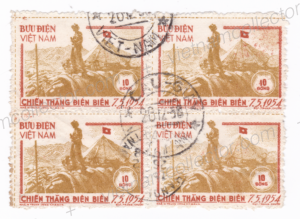
Beware of cancelled to order (CTO) stamps that are worth a lot less than postally used specimen. Remember catalogue pricing reflects postally used specimen. Crafty sellers like to gloss over that point to sell cheap CTO stamps at higher prices. Here is a typical block of four CTO stamps showing the typical Hanoi favor cancel. Notice it is always struck evenly across four stamps.This block of four shows the variety of flag drifted upwards.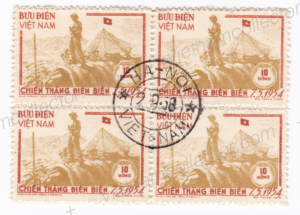
Postally used set of the four imperforated stamps that exist. The orange-yellow 50D value is on the left and the lemon-yellow version is on the right:
Despite the improved production conditions errors do occur. Here is a cancelled to order block of four of the 10D stamp on which the bottom right stamp is missing most of the 10D nominal value.

Detailed scan of the affected area.
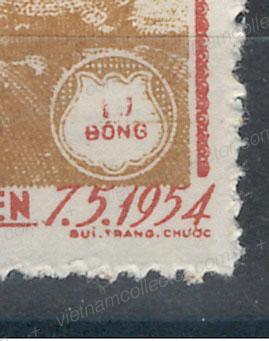
Here is single 10D stamp cancelled to order on which the top right frame is partially broken.
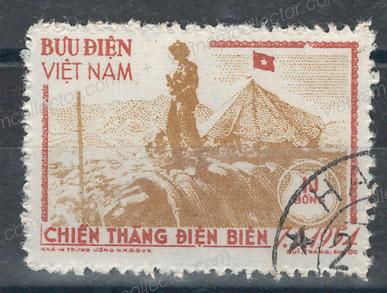
Detailed scan of the affected area.
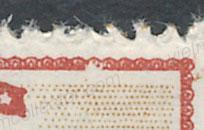
Another cancelled to order block of four of the 10D value on which the “G” of “Dong” in the nominal value is partially broken.
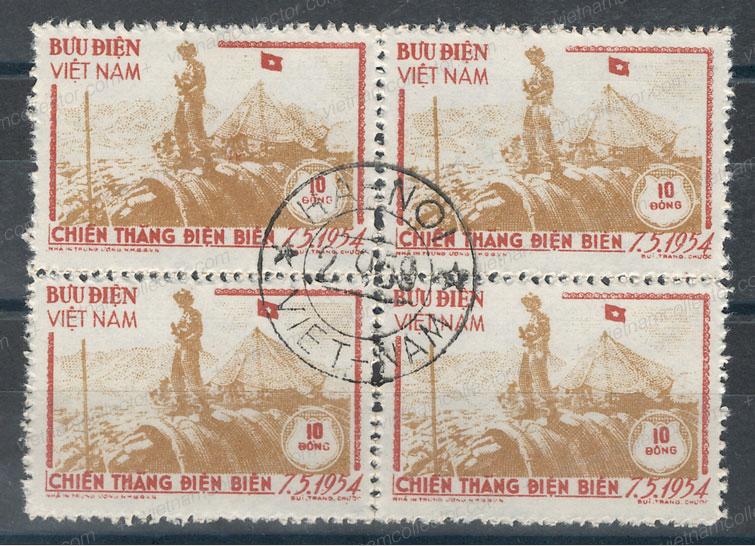
Detailed scan of the affected area.
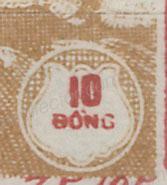
A repeated plate error is seen here on the left of the two 150 Dong stamps. The “4” in “1954 is somewhat sheared off at the bottom so that the “4” looks more like an “A”. It is a pretty common error that is not too hard to find.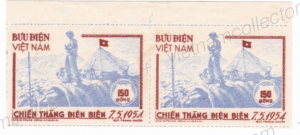
Here is a single mint 150D stamp on which the “N” in “DONG in the nominal value is short.
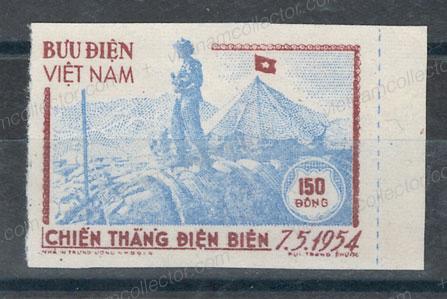
Detailed scan of the affected area.
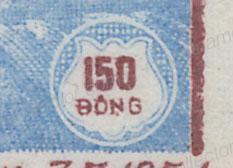
Passer shifts, where the brown color was misaligned with the blue color such as on these three stamps, do occur as well:
Here is a spectacular block of six that was compromised by a paper fold on the two center stamps. The fold caused white vertical strips on four stamps and a shift of the blue color on the left pair of stamps: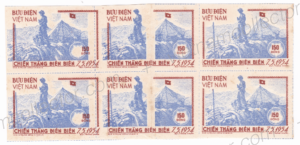
This block of four shows a large failure of the brown color printing process on the two top stamps resulting in missing tent flags and inscriptions on the right stamp:
While postal traffic picked up somewhat after the French left North Vietnam, complete letters from the period are still rare, especially local ones. It is more common to find an international letter to a fellow socialist country as there was still limited contact with the West.
Multiple franking of the 10D Dien Bien Phu stamp paying a 40 Dong postage on a post card sent from Hanoi to Laos. Intra-Regional mail (i.e. within the former Indochina) is hard to find as the climatical conditions and raw material shortages were not conducive to preserve such items. It is not quite clear what the correct post card postage to Laos was in September of 1958 (it already stood at 80D for a domestic post card as of March 12th, 1957 and was probably raised by 50% as of November 1st, 1957 when the domestic letter tariff was also raised by 50%). The manuscript “80” next to the “T” hand stamp may indicate that the card was either short of 40D plus a 40D penalty or it simply may indicate that the post card tariff to Laos amounted to 120D (i.e. short by 80D). Clear is that the postage was insufficient and hence a black boxed “T” hand stamp was added in Vietnam to indicate that additional postage was due upon delivery. This additional postage was collected by affixing 10 Piastre postage due stamp in Vientiane.
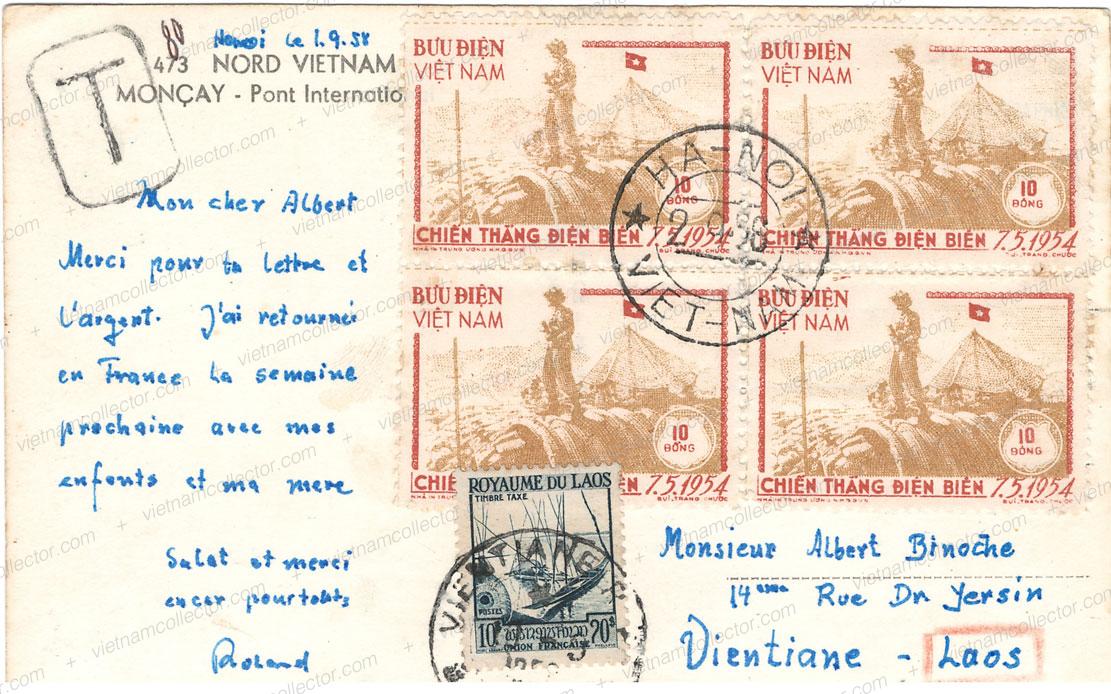
Here is a similar registered letter, also sent by the Czechoslovakian Embassy, mailed in January of 1957 and carrying one of the 1,000D Mac Thi Bu o’i stamps plus stamps from the Liberation of Hanoi, Bai Thu’o’ng dam, Bien Dien Phu and Tran Dang Ninh sets for an overall postage of 1,480D. Czech arrival cancel from February 4th, 1957.
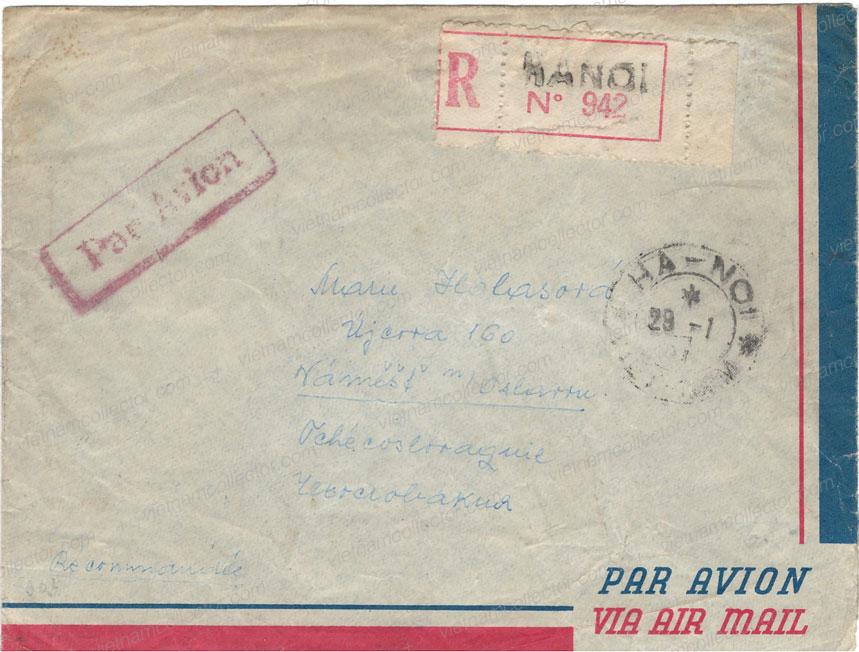
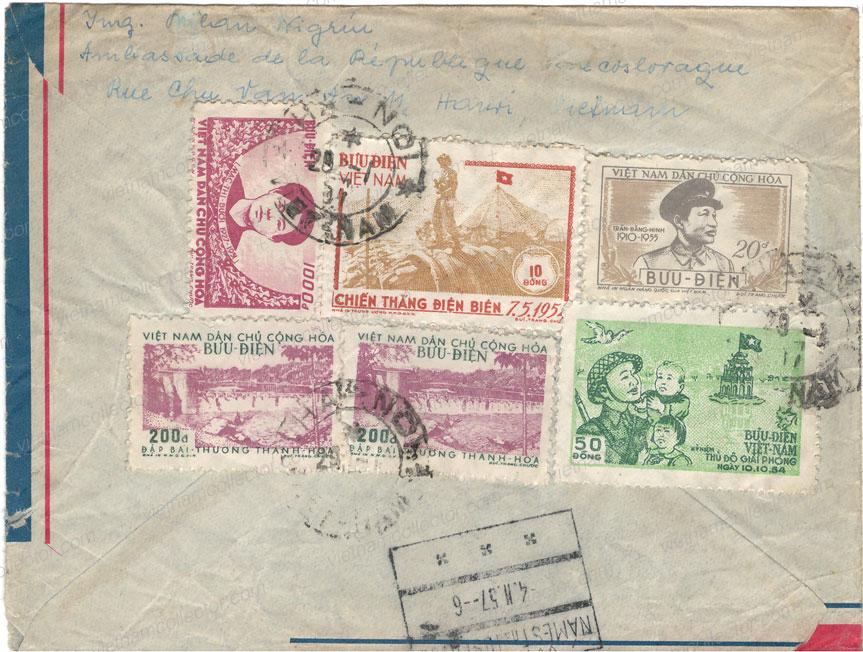
Mixed franking of the 500D Production and Thrift stamp together with the 100D HCM, 20D (2) Tran Dang Ninh and 10D Dien Bien Phu stamp paying an overall postage of 650D on an international air mail letter sent from Hanoi to Czechoslovakia in January of 1958.
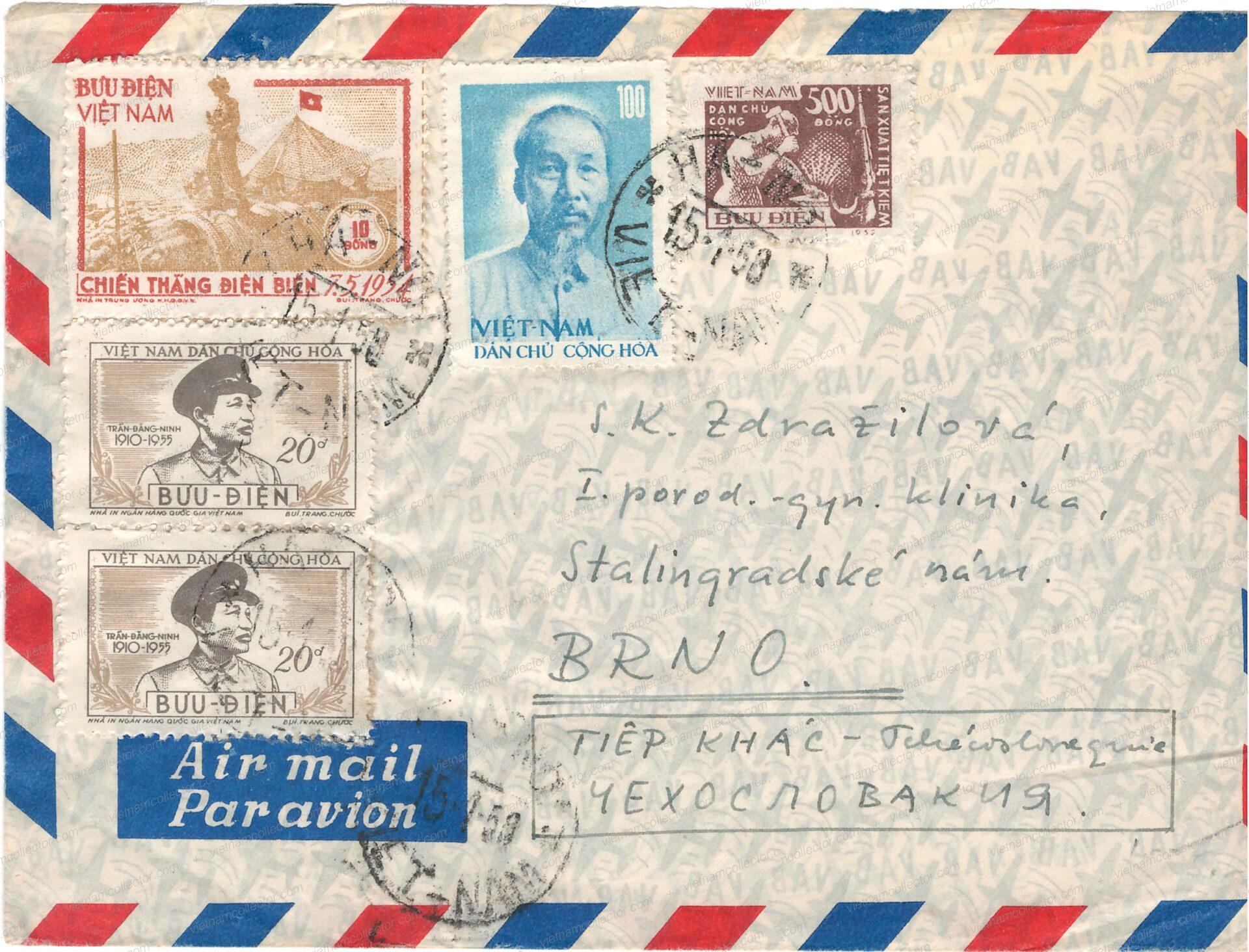
Mixed franking of the 300D and 500D Railroad stamps together with four 10D Dien Bien Phu stamps paying an overall postage of 840D on an international air mail letter sent from Hanoi to East Germany in June of 1956. The standard surface letter rate at the time amounted to 300D and the air mail surcharge 270D for the first 5 grams of weight. So, this letter must have been quite a bit heavier than 5g.
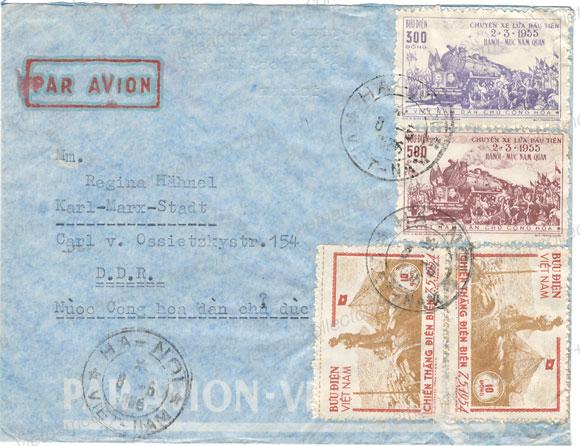
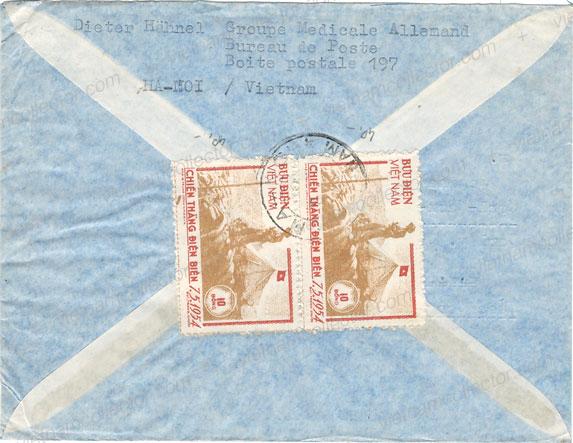
Mixed franking of the 300D Railroad stamps together with two 10D Dien Bien Phu and one 500D Production and Thrift stamps paying an overall postage of 820D on an international air mail letter sent from Hanoi to The Soviet Union in August of 1955. The standard surface letter rate at the time amounted to 300D and the air mail surcharge 270D for the first 5 grams of weight. So, this letter must have been quite a bit heavier than 5g. Interesting red boxed “de Hanoi a Canton” air mail routing stamp. Moscow arrival cancel on the reverse.
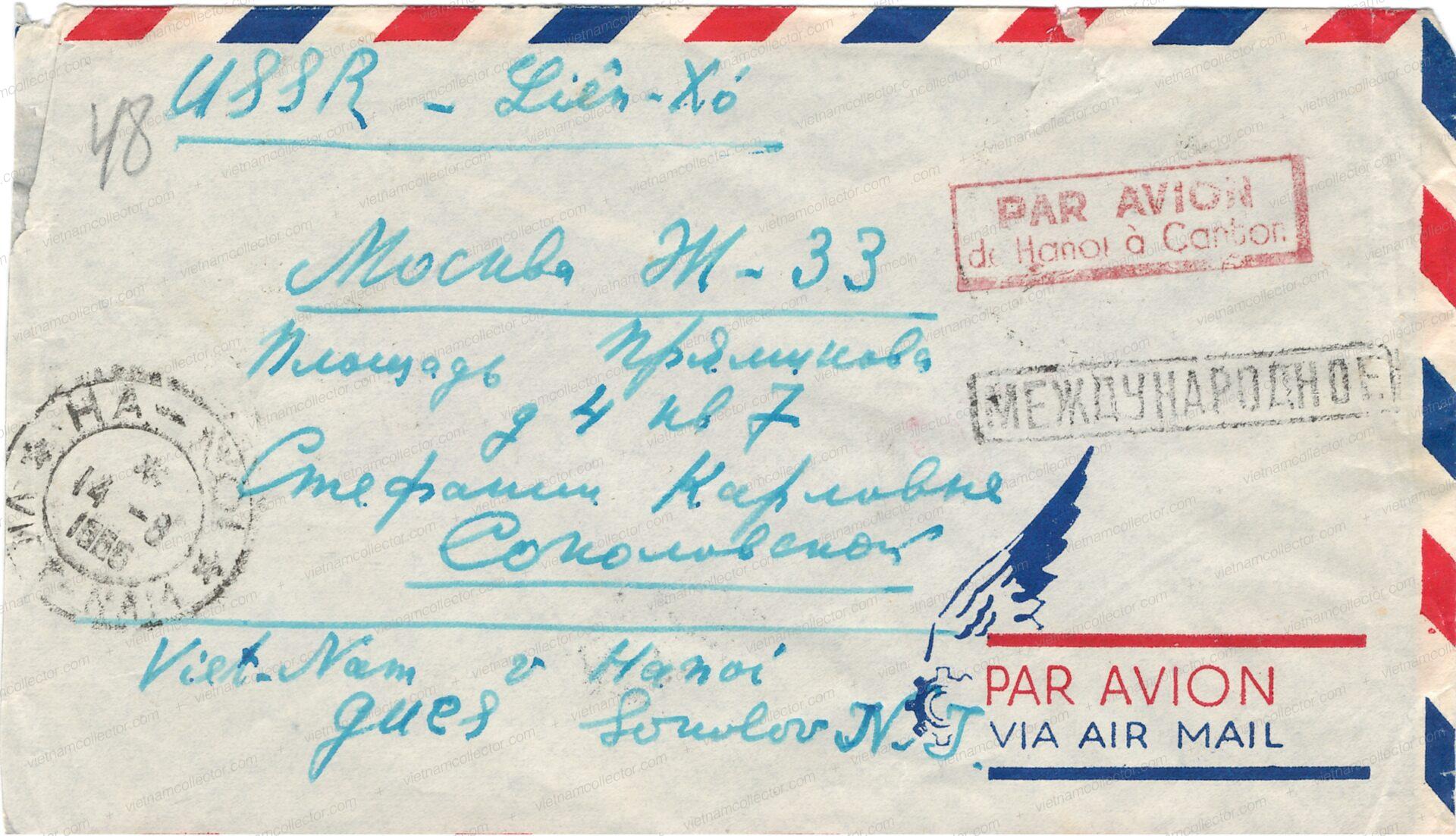
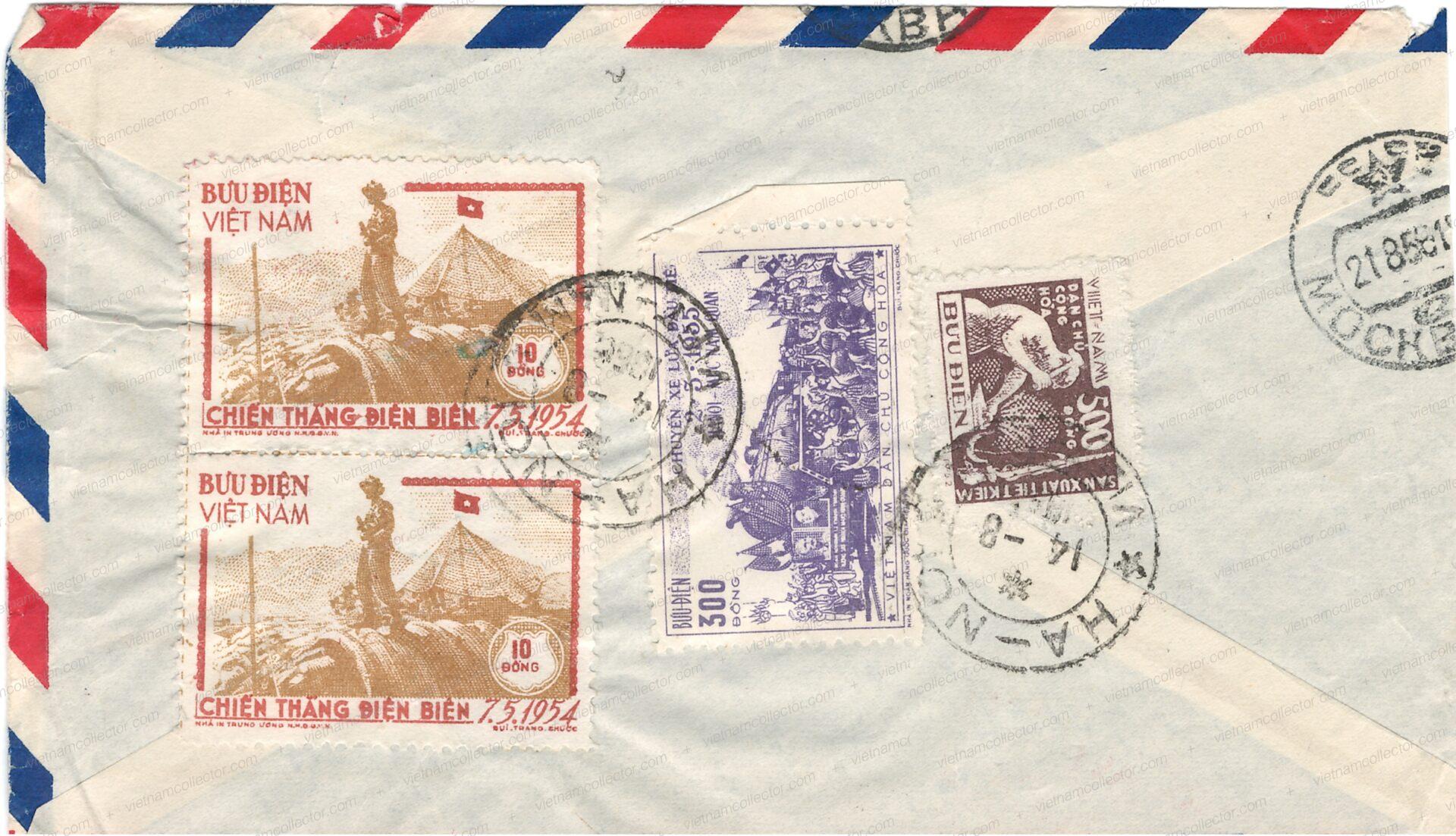
Mixed franking of the 20D (2) and 50D Agrarian Reform stamps together with stamps from the Production and Thrift and Dien Bien Phu sets paying the standard surface letter rate of 300D in February of 1955. Sent by a member of the East German Embassy to Dresden. The yellow rectangular hand stamp on the left 20D value is a Chinese censor mark that was applied when the letter traversed China en route to the Beijing-Moscow railway.
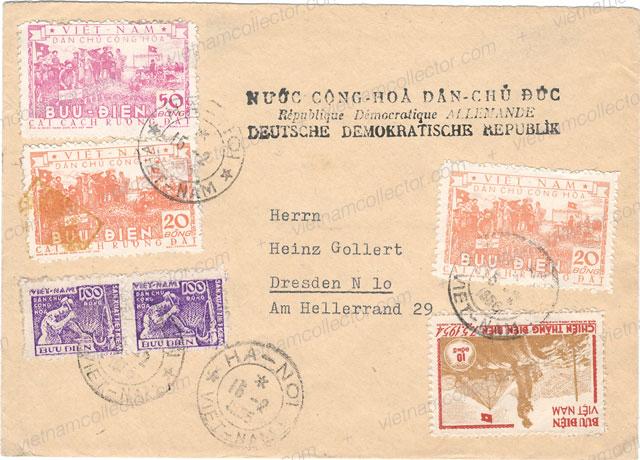
Mixed franking of the 50D Friendship stamp together with the 500D Production and Thrift, 20D Tran Dang Ninh and 10D Bien Dien Phu stamps paying an overall postage of 580D on an international letter sent in December of 1960 from Hanoi Czechoslovakia. This type of decorated envelope was not typical for North Vietnam at the time so it was most likely brought by the member of the Czech Embassy from his home country.
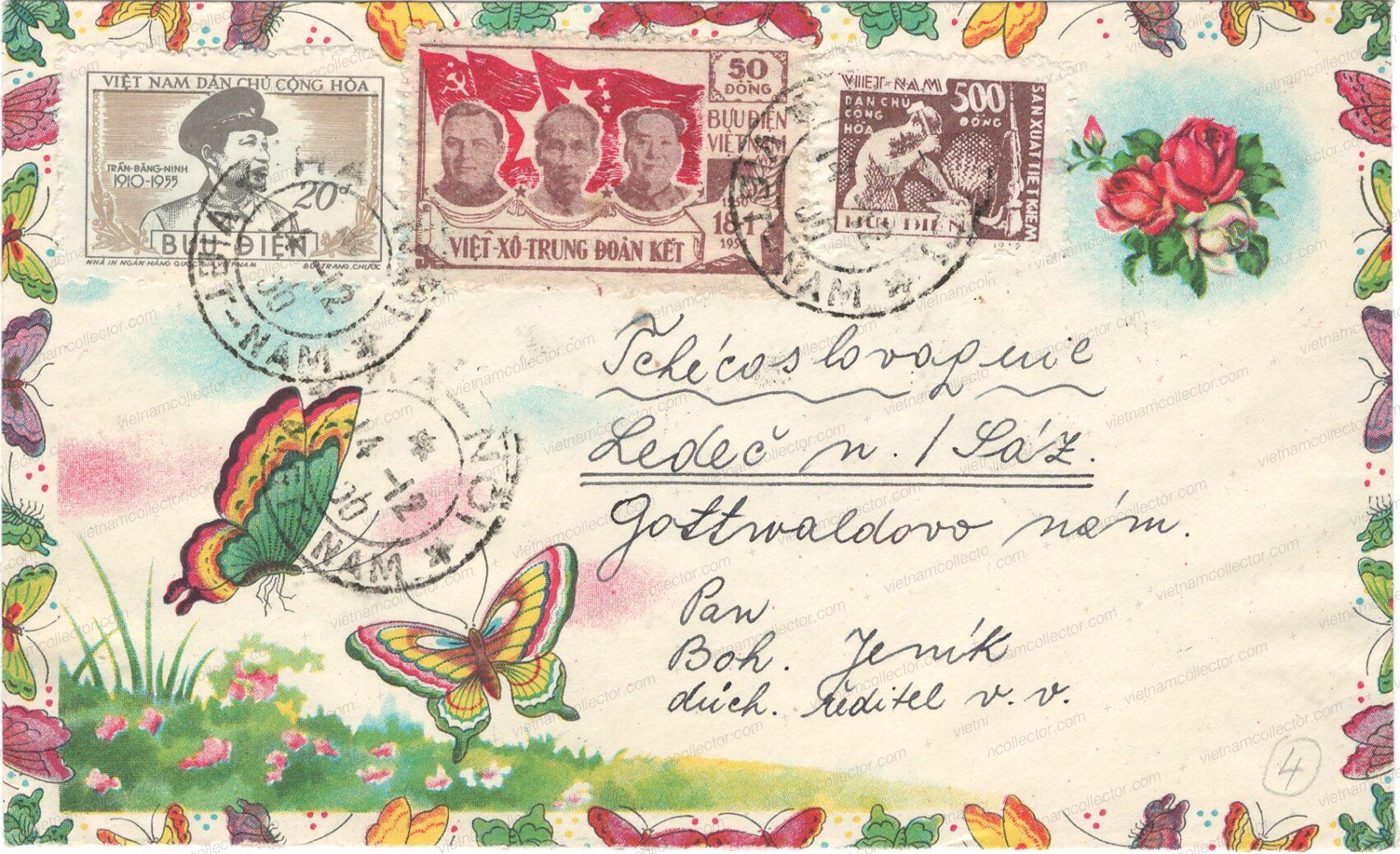
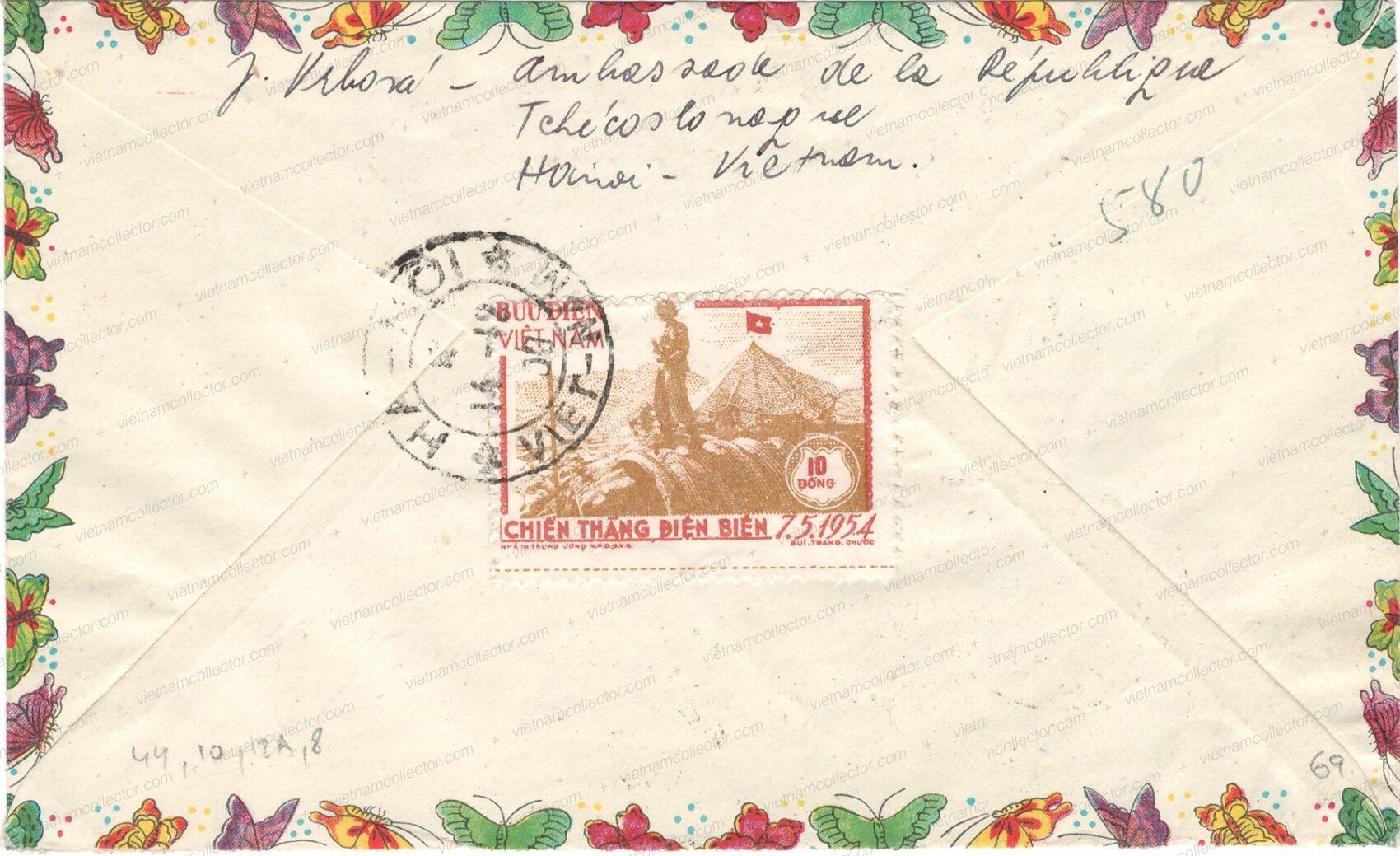
Below is a very rare local letter. It is franked with a single 50D imperforated in red/orange-yellow. The 50D represented a discounted intercity rate (which was also typical for Indochina before). The climate and raw material shortages ensured that paper did not survive too long. Since the stamps were issued in October, 1954 this letter represents a very early usage just a few days after the Viet Minh retook the city from the French. Propaganda cachet celebrating the liberation of Hanoi is at the top.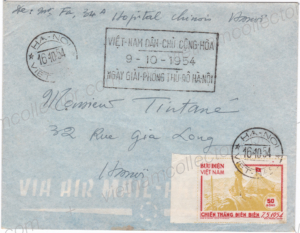
Mixed franking of the imperforate 50D Bien Dien Phu value together with the 500D Production and Thrift stamp paying an overall postage of 550D on an international air mail postcard sent from Hanoi to East Germany ink December of 1957. The message is limited to Christmas greetings. The international base rate for post cards was 200D plus 350D air mail surcharge. Very few postcards from these early years survive until today.

Spectacular multi-franked letter to China featuring a block of six of the 50D imperforated value in red/orange-yellow. The tariff in September of 1956 was still 300 Dong. Notice the small rectangular Chinese censor stamp on the back.
Air mail letter sent from Hanoi in April of 1957 to China bearing a block of four of the perforated 50D stamp (orange-yellow) plus a pair of the 100D Tran Dang Ninh stamps for an overall postage of 400D. The basic surface letter rate amounted to 300D plus 100D would be charged for every 5g of weight if mailed by air. This letter hence must have weighed under 5g. Note that the bottom left 50D stamp shows the variety of short 5 in 1954.
Mixed franking of the perforated 50D Dien Bien Phu stamp together with the 1,000D Return of the Government and 300D HCM Birthday stamps paying an overall postage of 1,350D on an international air mail letter sent in May of 1957 from Hanoi to East Germany. The postage paid is unusually high and may have reflected the registered air mail letter rate (300D base postage for 5g plus 350D Air Mail surcharge plus 600D Registration surcharge) or simply a very heavy letter that weighed well over the standard 5g.
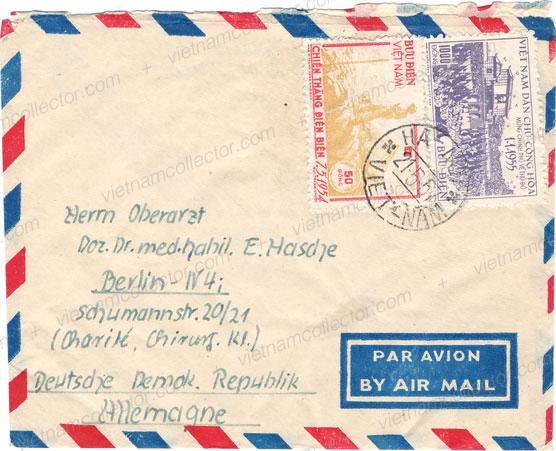
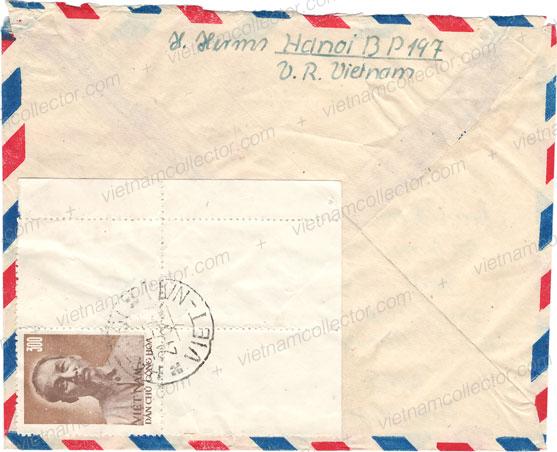
Mixed franking of two of the 300D Dam stamps (in the rare perforation 11.5) together with the perforated 50D Dien Bien Phu stamp paying an overall postage of 650D on an international air mail letter sent from Hanoi to East Germany in August of 1957. The letter is addressed to a high level doctor at the world famous Charite’ hospital in East Berlin. This was the correct tariff at that time (300D base rate plus 350D air mail surcharge for the first 5g in weight).
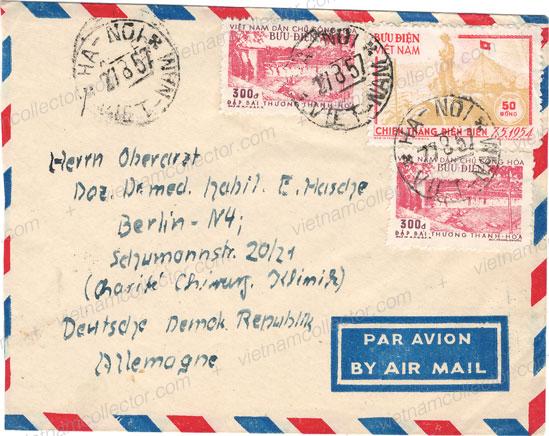
Mixed franking of the 50 and 150D Liberation of Hanoi stamps together with stamps from the Friendship and Dien Bien Phu sets paying an overall postage of 300D on an international surface letter sent in April of 1955 from Hanoi to West Germany. 300D was the correct postage at that time. The letter was sent by the Secretary of the President’s Council, Trinh Xuan-Con who was a high level party functionary that was Theo Klewitz’ inside contact into the North Vietnamese Government. He provided to Klewitz most of the early official and military letters that can still be found today. Without this connection very little postal history of occur and military letters would heave survived. Ex Klewitz.
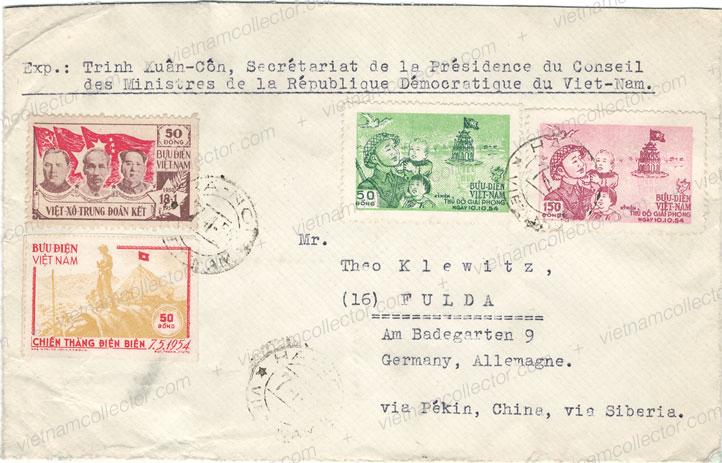
Very rare local letter sent from Hanoi to Yen-The, a small hamlet North of Hanoi on November 21st, 1957 using the new 150D standard letter tariff that had come in force on November 1st, 1957. Bad Giang transit and Yen-The arrival cancel (November 22nd) on the reverse. Most local letters perished during the many years of war, the tropical climate and raw material shortfalls.
Very rare international letter featuring the 150D imperforate Dien Bien Ph stamp and sent by a member of the military (Hom Thu T.103 K2 BC 11C) To Moscow, Soviet Union. Military cancel from the BC 11C unit. Moscow arrival cancel on the reverse. Note that the stamp shows the plate error 1 and 5 in 150 connected.
International letter mailed from Hanoi to China on November 5th, 1956 paying the surface latter rate that came in force as of July 1st, 1955 and featuring a pair of the imperforate 150D Dien Bien Phu stamps. Chinese transit and arrival cancels on the reverse (10.11.56 and 17.11.56) indicating a rather rapid postal tariff.

Here is another letter to China. This time from December of 1956. The rate was again 300 Dong made up of a pair of imperforated 150D stamps covering the standard surface tariff to China. Please note that the left stamp shows the plate error part of THANG missing.
Here is a very similar letter, this time with a pair of two of the 150D perforated stamps. Note the square and circular Chinese censor marks.
Very rare multiple franking of the imperforate 150D Dien Bien Phu stamps (4) paying an overall postage of 600D on an international air mail letter sent from Hanoi to East Germany in January of 1957.
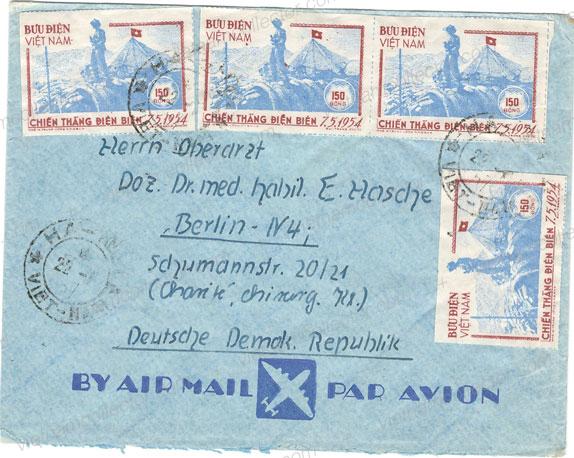
Mixed franking of the 150D imperforate Dien Bien Phu stamp together with the 500D Production and Thrift stamp paying an overall postage of 650D on an international air mail letter sent in May of 1957 from Hanoi to a physician in the world famous Charite’in East Berlin. Postage rates were changed on March 13th, 1957 when the standard surface letter rate amounted to 300D and the air mail surcharge for the first 5g of weight was 350D.
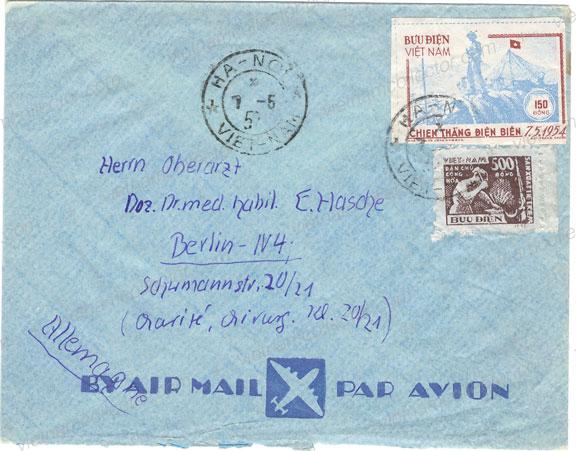
Mixed franking of one 150D value each (Dien Bien Phu and Liberation of Hanoi) paying the surface letter rate to China. Round and square Chinese censor hand stamps on the reverse.
Below is a letter to China with a mixed franking of early NVN stamps among them a block of four of the 10D value perforated. Note that the international postage to China went up from 300D at the end of 1956 to 400D on March 13th, 1957. Also note, that the letter was no longer censored by the Chinese as was the case for earlier letters.
Below is a spectacular international letter with a mixed franking to West Germany (ex Klewitz) from March of 1956. Letters to the West were very rare in the mid 50’s, especially registered ones. The overall postage amounted to 1,170 Dong and the back features a single stamp of the 10D perforated and a pair of the 150D perforated. Fulda arrival cancel.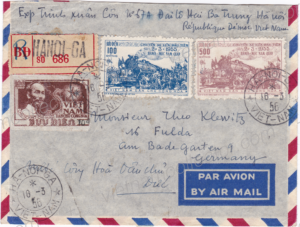
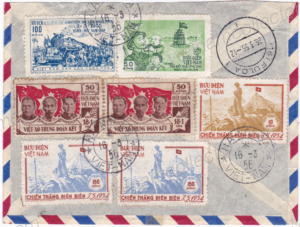
Below is a postcard franked with 550 Dong to Czechoslovakia that features a mixed franking with one 50D Dien Bien Phu stamp perforated.
Here is another example of the 550D tariff for post cards to Czechoslovakia but this time with the 50D imperforated.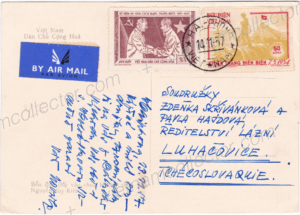
The tariff for a letter to other socialist countries was a bit higher at 650 Dong as is demonstrated by this letter from October, 1957 which was mailed by an employee of the East German Embassy to Marbach, East Germany. The mixed franking includes a single stamp 50D perforated.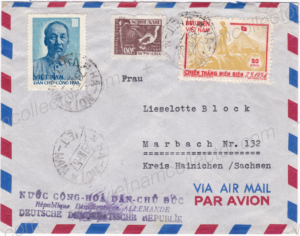
Letter franked with a single perforated 10 Dong stamp sent to Klewitz in February of 1966 (late usage). It is an interesting mixed currency franking. The pre 1959 stamps (960 Old Dong) had been devalued 1,000: 1 in March of 1959 so they were only worth 96 xu in 1966. Interesting also the use of the 150 Dong Official stamp from 1958. Normally these stamps were only available to Government Offices, Non-Governmental Organizations and foreign embassies. Together with the stamps in new currency the letter had an overall franking of 1.92 Dong. Since the standard 20 gram registered letter tariff to West Germany was only 1.10 Dong this large letter must have been heavier than the standard.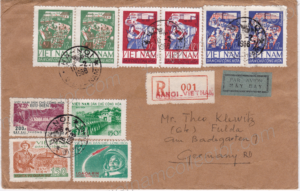
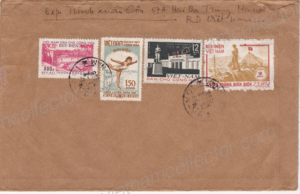
Rare express mail letter sent to Klewitz on the First Day Issuance in West Germany. The letter also carries the special cachet that was produced for the occasion. Rather playful use of the Dien Bine Phu stamps from 1954/1956 and 1964. The old stamps had already been devalued on March 1st, 1959 by 1,000:1 which meant that the 60 Dong the two values initially represented were only worth 0.06 New Dong in 1974. The over-all postage of the letter amounted to 57.06 Xu which is short of the proper tariff (1 Dong) for a standard express mail letter. The under-franking was apparently not noticed in Vietnam and Germany and the letter was delivered without postage due charges. Fulda arrival cancel on the reverse.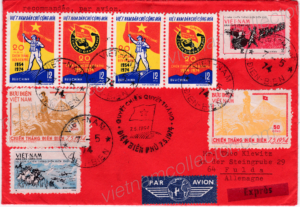
In order to facilitate official mail the Postal Authorities at the same time also issued a stamp with the same motive but instead of being denominated in Dong it had a face value of 0.6 kilo of husked rice. This was done with the back-drop of very rapid inflation in the North that made it necessary to constantly issue new stamps with higher values. Issuing the stamp in kilo rice essentially build in an automatic inflation adjustment as its face value rose along with the price of rice in there market. Like the main series for the general public the stamp was issued imperforated and perforated. The standard perforation was 11.5 and the perforation holes were very small resulting in a very short “stubby” and generally poor perforation. Michel also reports that the Nam Dinh post office issued a very rough trial perforation of 6.0 and this appears to be very rare as the editor has only seen that once in the Klewitz collection.
Here is mint block of four with perforation 11.5. Note, that the top left stamp is the error stamp that shows a re-occuring plate error in which the bottom of the “4” in “1954” is cut off making it look like “1951” and it also shows the short 9 at the bottom. The bottom right stamp shows the plate error “flag of the 5 partially missing”.
Here is a similar mint block of four this time imperforated. Again, the top left stamp is the error stamp showing the “1951” instead of “1954”.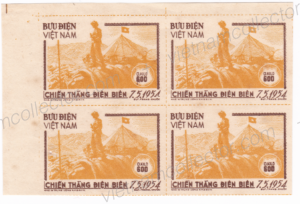
Here is another plate error on the bottom stamp of this imperforate pair. In it the “1” in “1954” is broken.
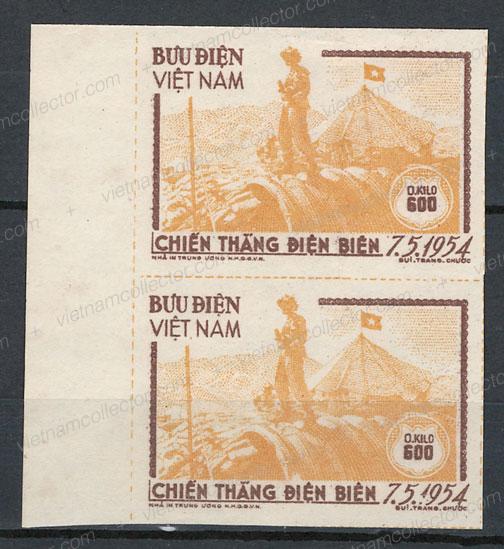
Detailed scan of the affected area.
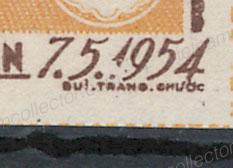
As often, the catalogues get the pricing of used stamps very wrong. Michel values used stamps at half the price of mint stamps and Scott values them at 2/3 of the price of mint stamps. Both makes little sense given the fact that these stamps are very easily available mint and incredibly hard to find used. Keep in mind that most official mail envelopes were destroyed upon receipt or ended up in Government archives that were then later raided or destroyed in what was perpetual war that lasted decades. Below is a used perforated stamp (11.5). Note the poor perforation and centering which is normal for this issue.
Very rare postally used pair of the perforated 0.6 kg Bien Dien Phu stamp on a piece. Used in May of 1955 in Hanoi.
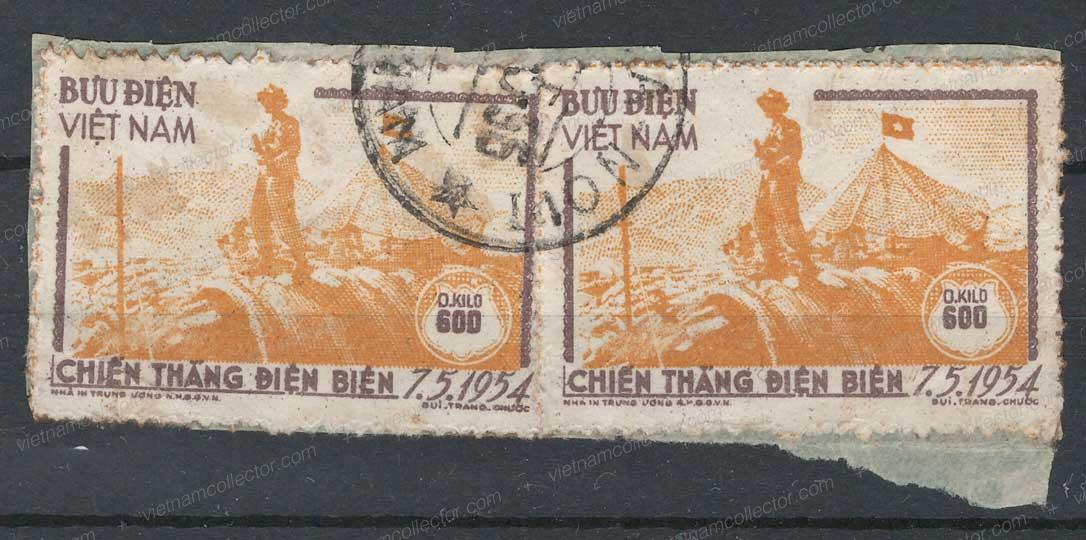
Below is a used imperforated specimen cancelled in Hanoi in 1955. This means the Scott catalogue which states that the imperforated stamp was issued in 1956 is clearly wrong.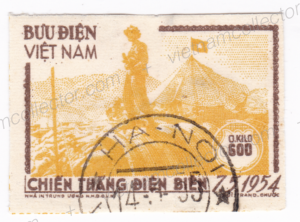
Below is a very rare cancelled specimen of the imperforate stamp showing the “1951” error. The error stamp is predominantly offered mint and extremely hard to find used.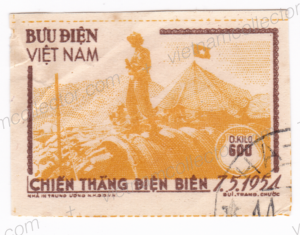
Complete letters are exceedingly rare and the editor has only seen two more, which are both in the Klewitz collection. Here is a letter sent in 1956 from Hanoi to Moscow. Moscow machine arrival cancel on the reverse.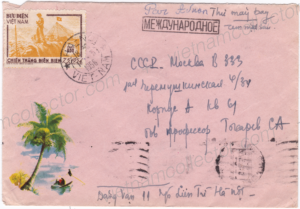
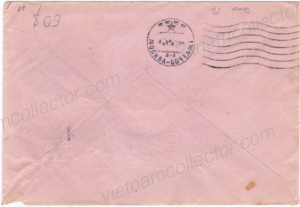
Mixed franking of the Bamboo Lanterns set together with stamps from the 100 Years Nobel Price, International Stamp Exhibition ESPANA, Dien Bien Phu and Liberation of South Vietnam sets. The letter also carries a military free frank that was not valid for international postage but was accepted by the postal clerk nevertheless. The 0.600kg imperforate Official Rice stamp from 1954 was technically still valid for postage but was improperly used on this private mail so was clearly philatelically motivated.
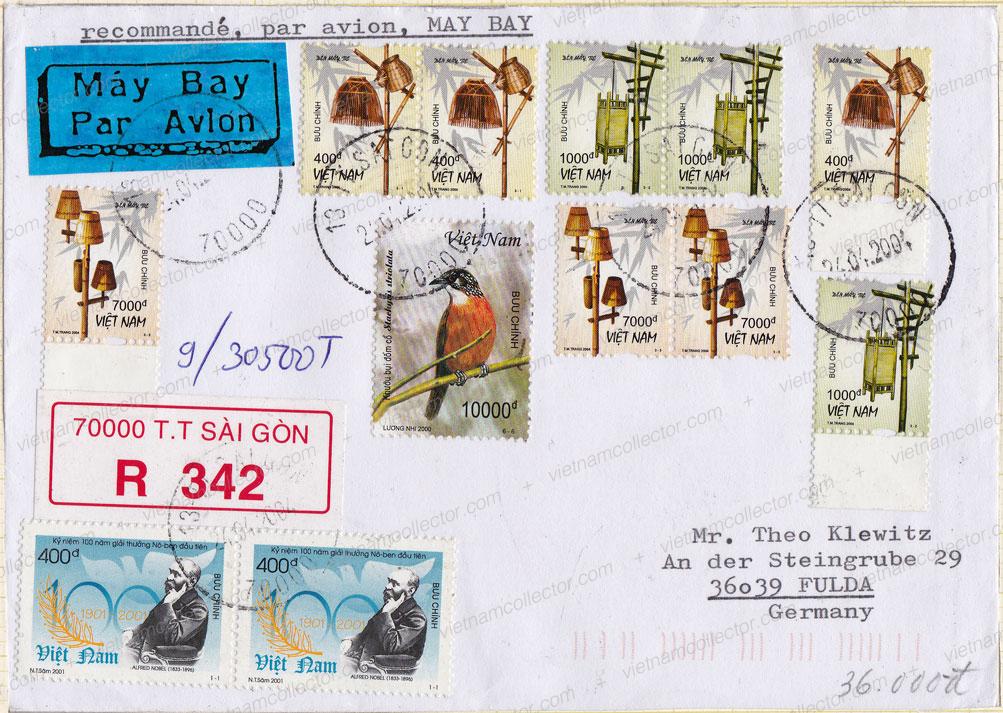
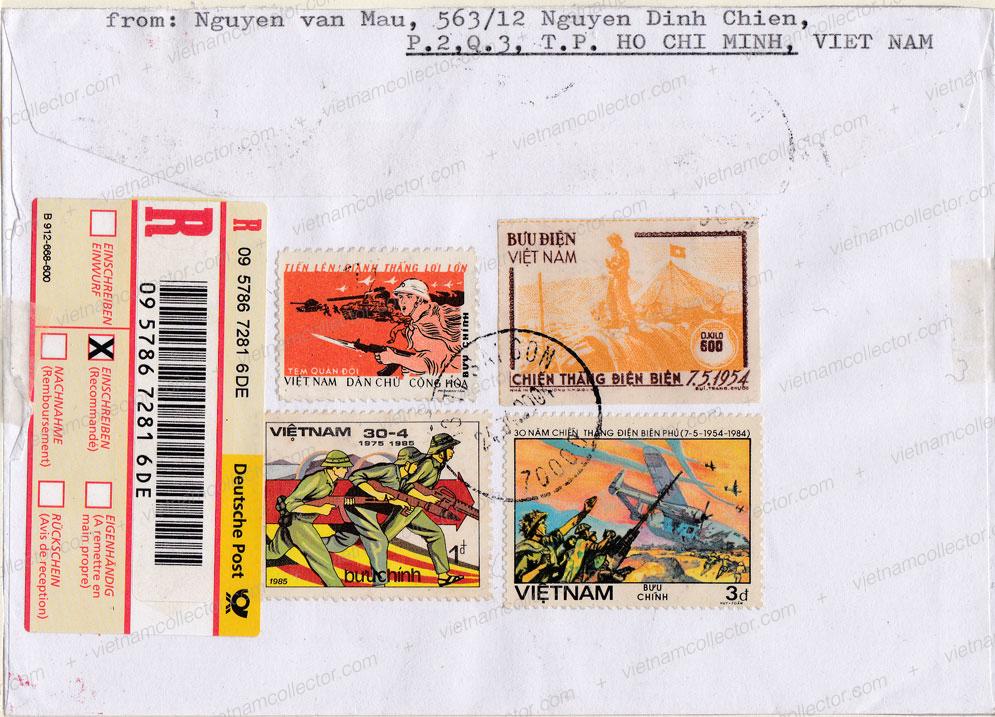
Registration Nr. 100031

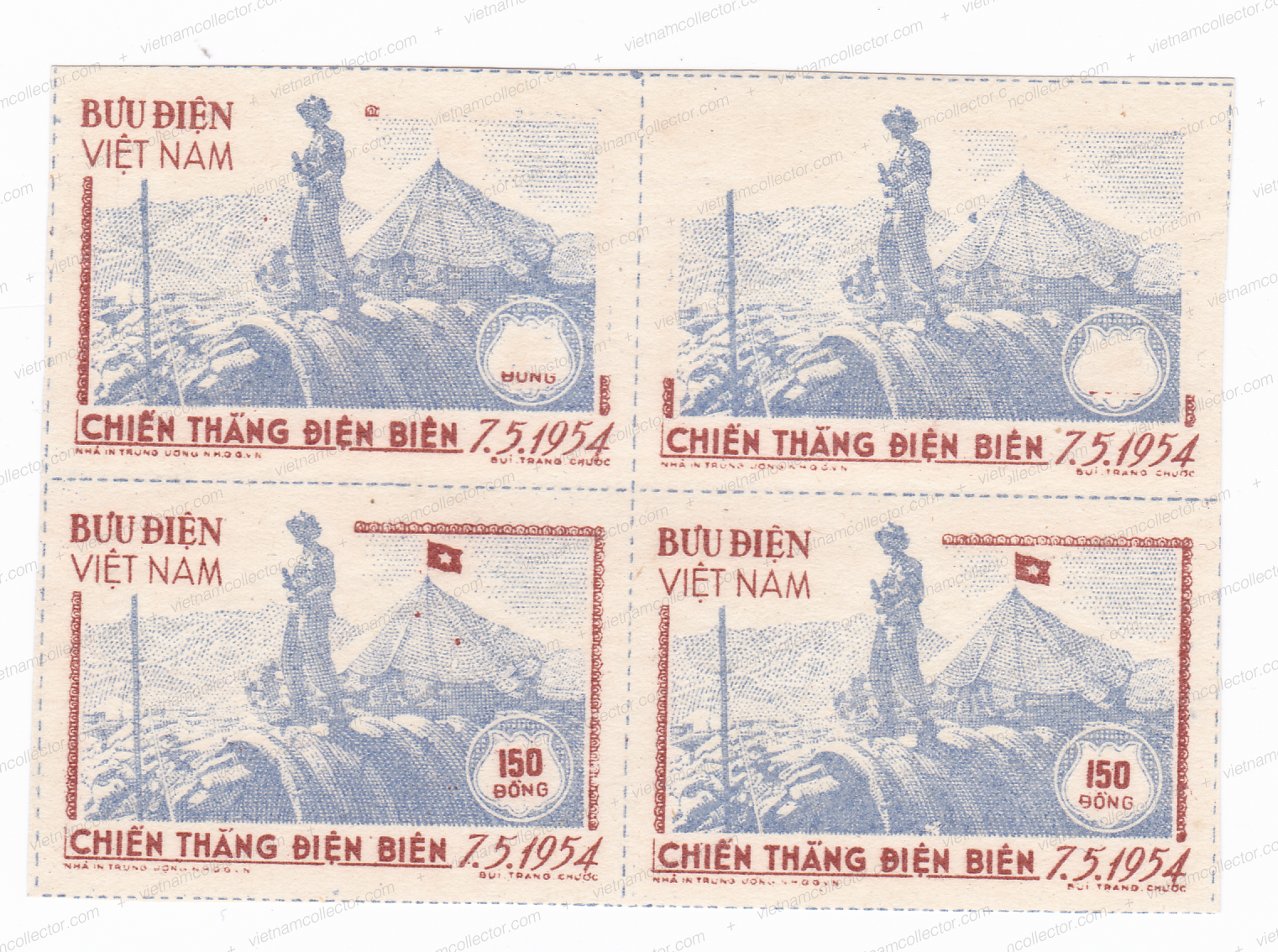



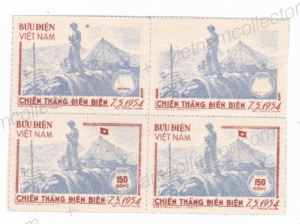
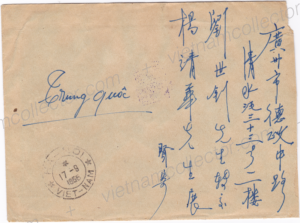
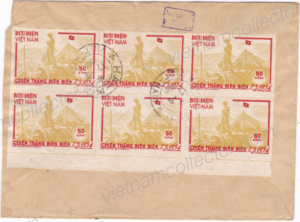
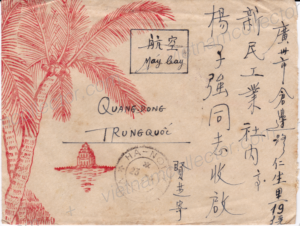
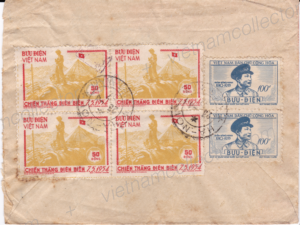
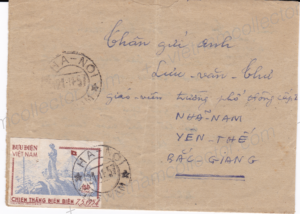
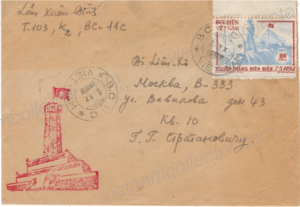
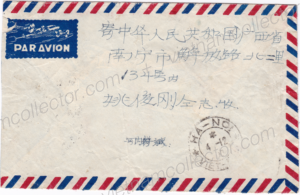
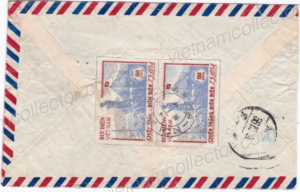
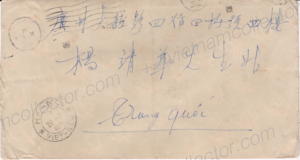
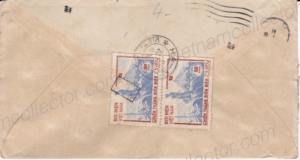
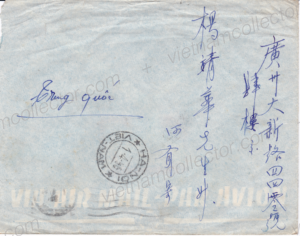
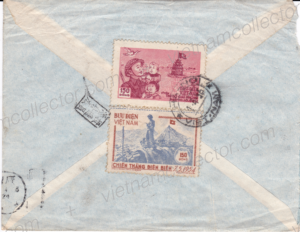
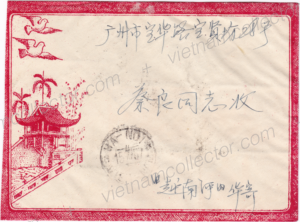
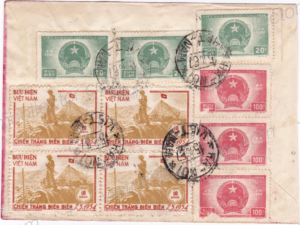
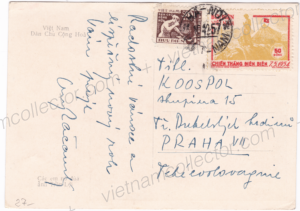
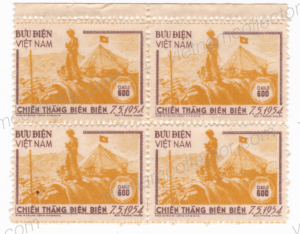
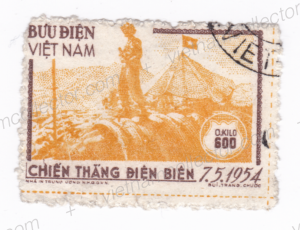
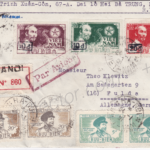
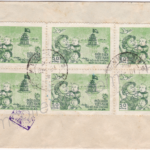
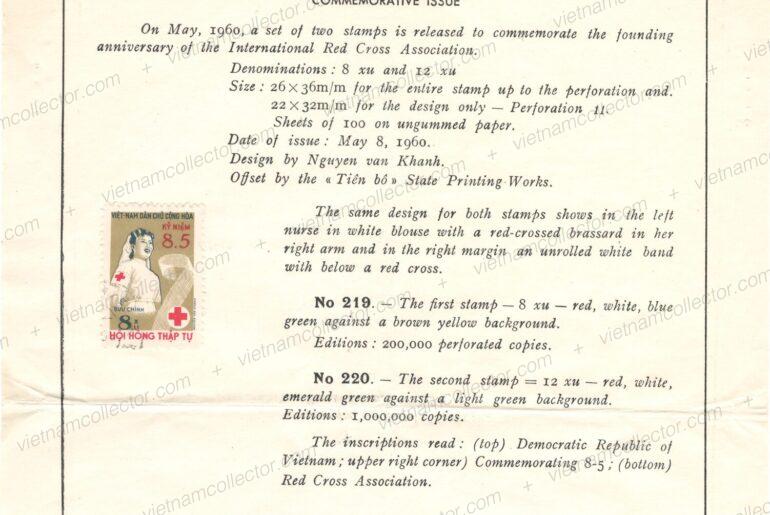
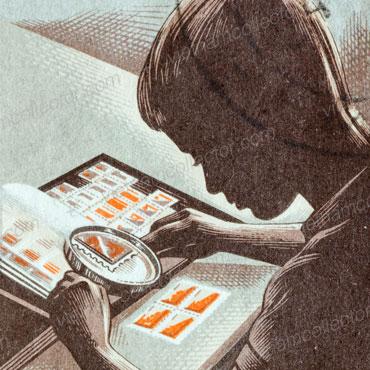
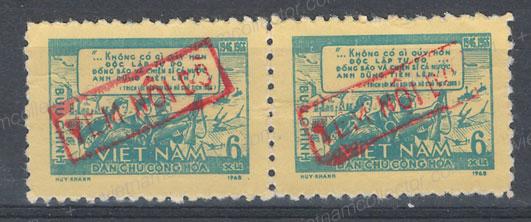
Comments are closed.